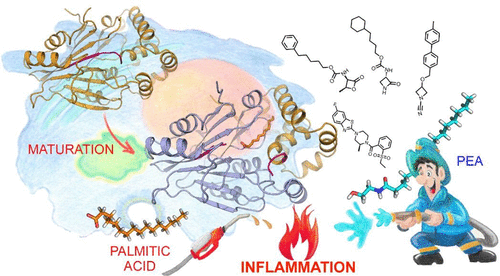当前位置:
X-MOL 学术
›
J. Med. Chem.
›
论文详情
Our official English website, www.x-mol.net, welcomes your feedback! (Note: you will need to create a separate account there.)
N-Acylethanolamine Acid Amidase (NAAA): Structure, Function, and Inhibition.
Journal of Medicinal Chemistry ( IF 7.3 ) Pub Date : 2020-03-19 , DOI: 10.1021/acs.jmedchem.0c00191 Daniele Piomelli 1, 2, 3 , Laura Scalvini 4 , Yannick Fotio 1 , Alessio Lodola 4 , Gilberto Spadoni 5 , Giorgio Tarzia 5 , Marco Mor 4
Journal of Medicinal Chemistry ( IF 7.3 ) Pub Date : 2020-03-19 , DOI: 10.1021/acs.jmedchem.0c00191 Daniele Piomelli 1, 2, 3 , Laura Scalvini 4 , Yannick Fotio 1 , Alessio Lodola 4 , Gilberto Spadoni 5 , Giorgio Tarzia 5 , Marco Mor 4
Affiliation

|
N-Acylethanolamine acid amidase (NAAA) is an N-terminal cysteine hydrolase primarily found in the endosomal–lysosomal compartment of innate and adaptive immune cells. NAAA catalyzes the hydrolytic deactivation of palmitoylethanolamide (PEA), a lipid-derived peroxisome proliferator-activated receptor-α (PPAR-α) agonist that exerts profound anti-inflammatory effects in animal models. Emerging evidence points to NAAA-regulated PEA signaling at PPAR-α as a critical control point for the induction and the resolution of inflammation and to NAAA itself as a target for anti-inflammatory medicines. The present Perspective discusses three key aspects of this hypothesis: the role of NAAA in controlling the signaling activity of PEA; the structural bases for NAAA function and inhibition by covalent and noncovalent agents; and finally, the potential value of NAAA-targeting drugs in the treatment of human inflammatory disorders.
中文翻译:

N-酰基乙醇胺酸酰胺酶(NAAA):结构,功能和抑制作用。
ñ-酰基乙醇胺酸酰胺酶(NAAA)是N端半胱氨酸水解酶,主要存在于先天和适应性免疫细胞的内体-溶酶体区室。NAAA催化棕榈酰乙醇酰胺(PEA)的水解失活,这是一种脂质衍生的过氧化物酶体增殖物激活的受体-α(PPAR-α)激动剂,在动物模型中发挥着深远的消炎作用。越来越多的证据表明,PPAR-α上NAAA调控的PEA信号是诱导和解决炎症的关键控制点,而NAAA本身则是抗炎药物的靶标。本观点讨论了这一假设的三个关键方面:NAAA在控制PEA信号传导活性中的作用;NAAA功能和被共价和非共价试剂抑制的结构基础;最后,
更新日期:2020-03-19
中文翻译:

N-酰基乙醇胺酸酰胺酶(NAAA):结构,功能和抑制作用。
ñ-酰基乙醇胺酸酰胺酶(NAAA)是N端半胱氨酸水解酶,主要存在于先天和适应性免疫细胞的内体-溶酶体区室。NAAA催化棕榈酰乙醇酰胺(PEA)的水解失活,这是一种脂质衍生的过氧化物酶体增殖物激活的受体-α(PPAR-α)激动剂,在动物模型中发挥着深远的消炎作用。越来越多的证据表明,PPAR-α上NAAA调控的PEA信号是诱导和解决炎症的关键控制点,而NAAA本身则是抗炎药物的靶标。本观点讨论了这一假设的三个关键方面:NAAA在控制PEA信号传导活性中的作用;NAAA功能和被共价和非共价试剂抑制的结构基础;最后,



























 京公网安备 11010802027423号
京公网安备 11010802027423号